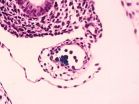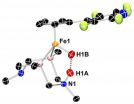(Press-News.org) This news release is available in French and German.
Man or woman? Male or female? In humans and other mammals, the difference between sexes depends on one single element of the genome: the Y chromosome. It is present only in males, where the two sexual chromosomes are X and Y, whereas women have two X chromosomes. Thus, the Y is ultimately responsible for all the morphological and physiological differences between males and females.
But this has not always been the case. A very long time ago, the X and Y were identical, until the Y started to differentiate from the X in males. It then progressively shrank to such an extent that, nowadays, it only contains about 20 genes (the X carries more than one thousand genes). When did the Y originate and which genes have been kept? The answer has just been brought to light by the team of Henrik Kaessmann, Associate Professor at the CIG (UNIL) and group leader at the SIB Swiss Institute of Bioinformatics, and their collaborators in Australia. They have established that the first « sex genes » appeared concomitantly in mammals around 180 million years ago.
4,3 billion genetic sequences
By studying samples from several male tissues – in particular testicles – from different species, the researchers recovered the Y chromosome genes from the three major mammalian lineages: placentals (which include humans, apes, rodents and elephants), marsupials (such as opossums and kangaroos) and monotremes (egg-laying mammals, such as the platypus and the echidna, a kind of Australian porcupine). In total, the researchers worked with samples from 15 different mammals, representing these three lineages, as well as the chicken, which they included for comparison.
Instead of sequencing all Y chromosomes, which would have been a « colossal task » according to Diego Cortez, researcher at CIG and SIB and main author of the study, the scientists « opted for a shortcut ». By comparing genetic sequences from male and female tissues, they eliminated all sequences common to both sexes in order to keep only those sequences corresponding to the Y chromosome. By doing so, they established the largest gene atlas of this « male » chromosome to date.
This study required more than 29,500 computing hours! A gigantic task, which could not have been performed without important technical means: the high-throughput DNA sequencers of the genomics platform at the Center for Integrative Genomics, for the generation of the genetic sequences, and the calculation means of Vital-IT, SIB's high-performance computing centre, for the biological analyses.
Two independent sex-determining genes
The study shows that the same sex-determining gene, named SRY, in placentals and marsupials had formed in the common ancestor of both lineages around 180 million years ago. Another gene, AMHY, is responsible for the emergence of Y chromosomes in monotremes and appeared some 175 million years ago. Both genes, which according to Henrik Kaessmann are «involved in testicular development », have thus emerged « nearly at the same time but in a totally independent way ».
The nature of the sex-determination system present in the common ancestor of all mammals remains unclear, given that mammalian Y chromosomes did not yet exist at that time - at least not those discovered in this study. So what triggered back then that an individual was born male or female? Was this determination linked to other sex chromosomes, or even environmental factors such as the temperature? The latter is not an unreasonable scenario, given that temperature determines sex in present-day crocodiles. As far as mammals are concerned, «the question remains open », concludes Diego Cortez.
INFORMATION:
Male or female?
The first sex determining genes appeared in mammals some 180 million years ago
2014-04-23
ELSE PRESS RELEASES FROM THIS DATE:
Hundreds of genetic mutations found in healthy blood of a supercentenarian
2014-04-23
April 23, 2014 – Genetic mutations are commonly studied because of links to diseases such as cancer; however, little is known about mutations occurring in healthy individuals. In a study published online in Genome Research, researchers detected over 400 mutations in healthy blood cells of a 115-year-old woman, suggesting that lesions at these sites are largely harmless over the course of a lifetime.
Our blood is continually replenished by hematopoietic stem cells that reside in the bone marrow and divide to generate different types of blood cells, including white blood ...
From liability to viability: Genes on the Y chromosome prove essential for male survival
2014-04-23
CAMBRIDGE, Mass. (April 23, 2014) – Despite a well-documented history of dramatic genetic decay, the human Y chromosome has over the course of millions of years of evolution managed to preserve a small set of genes that has ensured not only its own survival but also the survival of men. Moreover, the vast majority of these tenacious genes appear to have little if any role in sex determination or sperm production.
Taken together, these remarkable findings—published this week in the journal Nature—suggest that because these Y-linked genes are active across the body, they ...
New target for prostate cancer resistant to anti-hormone therapies
2014-04-23
ANN ARBOR, Mich. — Prostate cancer becomes deadly when anti-hormone treatments stop working. Now a new study suggests a way to block the hormones at their entrance.
Researchers from the University of Michigan Comprehensive Cancer Center have found that a protein called BET bromodomain protein 4 binds to the hormone androgen receptor downstream of where current therapies work – targeting androgen receptor signaling.
This could mean that when prostate cancer becomes resistant to current treatments, it might remain sensitive to a drug that targets BET bromodomain proteins. ...
Quality control guidelines for genomics studies
2014-04-23
Sequencing an entire human genome is faster and cheaper than ever before, leading to an explosion of studies comparing the genomes of people with and without a given disease. Often clinicians and researchers studying genetic contributions to a certain disease encounter variations that appear to be responsible, only to find other people with the same mutation who don't have the disease or who are affected to a lesser degree.
How do doctors pinpoint the genetic changes that really cause disease? An open-access policy paper to be published Wednesday in Nature proposes guidelines ...
Picky male black widow spiders prefer well-fed virgins
2014-04-23
New University of Toronto Scarborough research shows that male black widow spiders prefer their female mates to be well-fed virgins – a rare example of mate preference by male spiders.
The study, authored by UTSC post-doc Emily MacLeod and Maydianne Andrade, a professor in UTSC's Department of Biological Sciences, found in both controlled field studies and the wild that males overwhelmingly chose to mate with well-fed, unmated females. They also found male black widows can tell whether a potential mate is well-fed and unmated by pheromones released by females.
"This ...
Halving hydrogen
2014-04-23
RICHLAND, Wash. -- Like a hungry diner ripping open a dinner roll, a fuel cell catalyst that converts hydrogen into electricity must tear open a hydrogen molecule. Now researchers have captured a view of such a catalyst holding onto the two halves of its hydrogen feast. The view confirms previous hypotheses and provides insight into how to make the catalyst work better for alternative energy uses.
This study is the first time scientists have shown precisely where the hydrogen halves end up in the structure of a molecular catalyst that breaks down hydrogen, the team reported ...
Increased infrastructure required for effective oil spill response in US Arctic
2014-04-23
WASHINGTON – A changing climate is increasing the accessibility of U.S. Arctic waters to commercial activities such as shipping, oil and gas development, and tourism, raising concern about the risk of oil spills. A new report from the National Research Council says that a full suite of proven oil response tools is needed to address potential oil spills in U.S. Arctic waters, but not all of them are readily available. While much is known about both oil behavior and response technologies in ice-covered environments, there are areas where additional research would enable ...
On the defensive
2014-04-23
People diagnosed with Huntington's disease, most in their mid-thirties and forties, face a devastating prognosis: complete mental, physical, and behavioral decline within two decades. "Mutant" protein clusters, long blamed for the progression of the genetic disease, have been the primary focus of therapies in development by pharmaceutical companies. But according to new research from Prof. Gerardo Lederkremer and Dr. Julia Leitman of Tel Aviv University's Department of Cell Research and Immunology, in collaboration with Prof. Ulrich Hartl of the Max Planck Institute for ...
ASTRO issues guideline on the role of postoperative radiation therapy for endometrial cancer
2014-04-23
Fairfax, Va., April 23, 2014— The American Society for Radiation Oncology (ASTRO) has issued a new guideline, "The Role of Postoperative Radiation Therapy for Endometrial Cancer: An ASTRO Evidence-Based Guideline," that details the use of adjuvant radiation therapy in the treatment of endometrial cancer. The guideline's executive summary is published in the May-June 2014 issue of Practical Radiation Oncology (PRO), the official clinical practice journal of ASTRO. The full-length guideline is available as an open-access article online at http://www.practicalradonc.org.
ASTRO's ...
Conservation priorities released for several protected areas along US-Mexico border
2014-04-23
This news release is available in French and Spanish.
Montreal, 23 April 2014—Today, the CEC released its Conservation Assessment for the Big Bend-Río Bravo Region: A Binational Collaborative Approach to Conservation, which identifies 29 priority conservation areas in a region straddling the United States-Mexico border that includes 11 different protected areas in the states of Texas, Coahuila, and Chihuahua. This region features unique, highly diverse arid and semi-arid habitats inhabited by rare and endangered plants and animals, and provides a vital migratory ...
LAST 30 PRESS RELEASES:
Drone sampling of whale breath reveals first evidence of potentially deadly virus in Arctic
Roman soldiers defending Hadrian’s Wall infected by parasites, study finds
Pinochet’s prisoners were tormented with music but still found solace in it, a new book reveals
Fertility remains high in rural Tanzania despite access to family planning
AI-assisted device can improve autism care access
Kinetic careers
Uncovering how parasitic plants avoid attacking themselves to improve crop resistance
Nanoparticle vaccine strategy could protect against Ebola and other deadly filoviruses
Study finds brain care score can predict risk of stroke across racial groups
Key lung immune cells can intensify allergic reactions
Do hormones explain why women experience more gut pain?
New materials conduct ions in solids as easily as in liquids
Breakthrough of the Year: Renewable energy begins to eclipse fossil fuel-based sources
LLM use is reshaping scientific enterprise by increasing output, reducing quality and more
Introducing LightGen, a chip for ultra-fast, ultra-efficient generative AI
Astronomers see fireworks from violent collisions around nearby star
ACC/AHA issue new guideline on managing congenital heart disease in adults
Cosmic crash caught on camera
Is talented youth nurtured the wrong way? New study shows: top performers develop differently than assumed
Ants: An untapped resource in the development of antibiotics?
Archaeologists use AI to create prehistoric video game
Mitochondria migrate toward the cell membrane in response to high glucose levels
Tiny viral switch offers hope against drug-resistant bacteria
Most parents aware of early peanut introduction guidelines, but confused about details
HPV vaccine can protect against severe lesions of the vulva and vagina
Virtual care provision and emergency department use among children and youth
Quadrivalent HPV vaccine and high-grade vulvovaginal lesions
Insights into dry eyes gained from stem cell-derived tear glands
Researchers identify 166 human pluripotent stem cell lines available for use in clinical applications
Europa Clipper instrument uniquely observed interstellar comet 3I/ATLAS
[Press-News.org] Male or female?The first sex determining genes appeared in mammals some 180 million years ago




